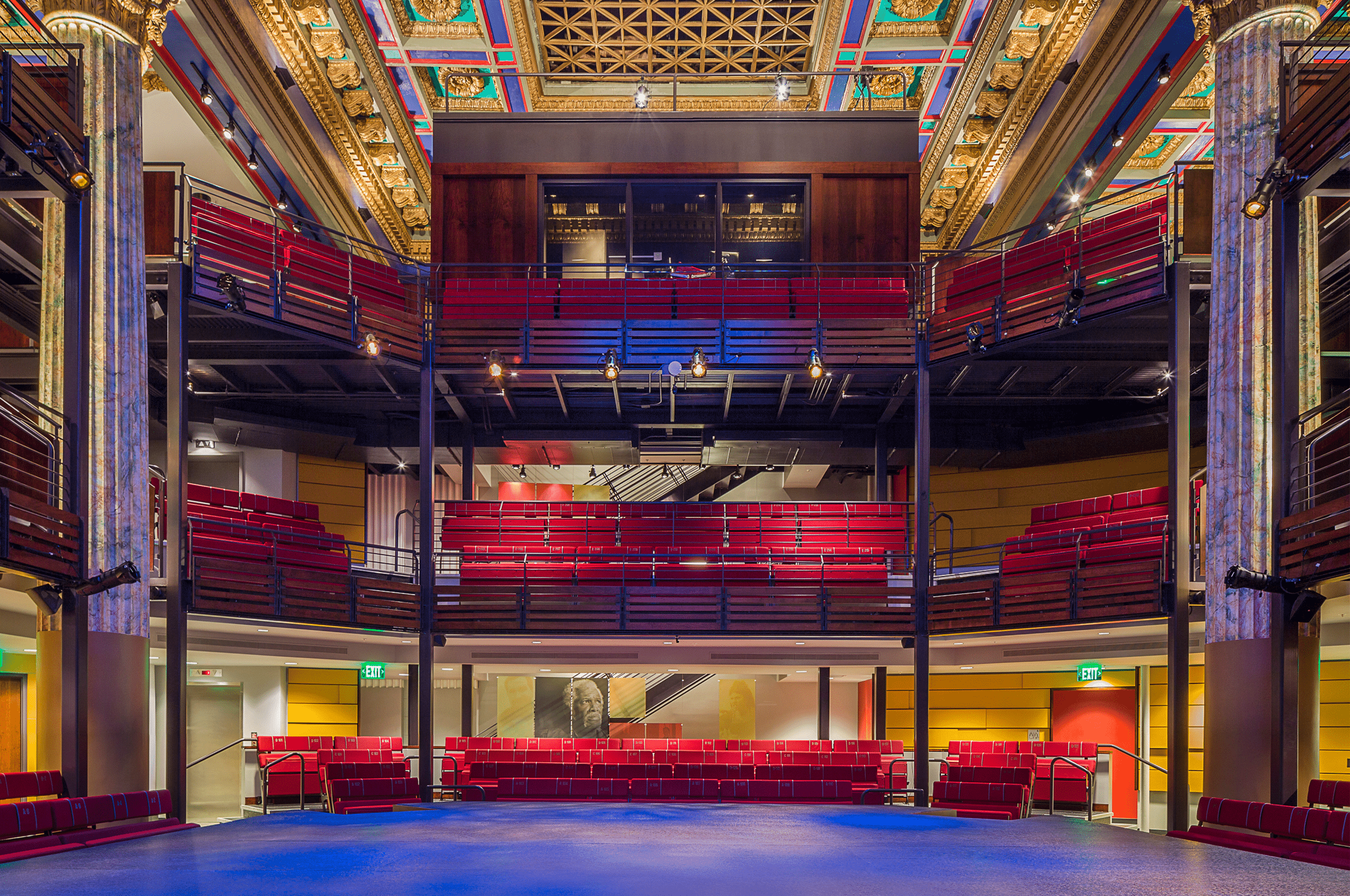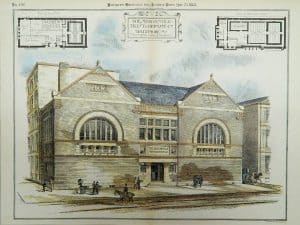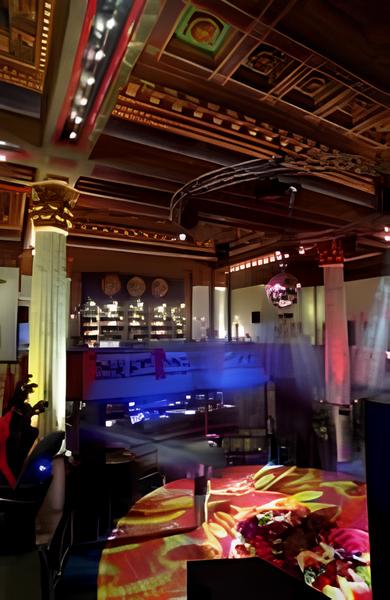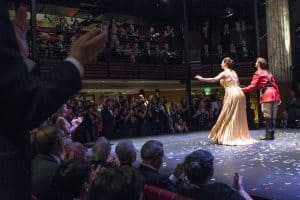Our Theatre
A Baltimore Landmark
 In 2014, Chesapeake Shakespeare Company transformed a landmark bank building into a theatre for the classics. An architectural gem, this Romanesque building was designed by Wyatt & Sperry and built in 1885 for the Mercantile Trust & Deposit Company. Bank promotions touted the impenetrability of its vaults. In 1904, the bank withstood the Great Fire of Baltimore and the vaults held. Today, one vault holds a costume studio. Another holds our PNC Family Room for Shakespeare’s youngest fans.
In 2014, Chesapeake Shakespeare Company transformed a landmark bank building into a theatre for the classics. An architectural gem, this Romanesque building was designed by Wyatt & Sperry and built in 1885 for the Mercantile Trust & Deposit Company. Bank promotions touted the impenetrability of its vaults. In 1904, the bank withstood the Great Fire of Baltimore and the vaults held. Today, one vault holds a costume studio. Another holds our PNC Family Room for Shakespeare’s youngest fans.
 The Mercantile Trust & Deposit Company opened in 1886 with fire-proof and burglar-proof vaults designed to hold valuables: Families left silver, jewelry, deeds, and other objects here for safekeeping. There was a separate vault for the ladies’s privacy when managing their deposits. The Mercantile Trust & Deposit became a pioneer in the concept of trust management and a “department store” of banking, in which many services were offered under one roof. The building was expanded in 1887.
The Mercantile Trust & Deposit Company opened in 1886 with fire-proof and burglar-proof vaults designed to hold valuables: Families left silver, jewelry, deeds, and other objects here for safekeeping. There was a separate vault for the ladies’s privacy when managing their deposits. The Mercantile Trust & Deposit became a pioneer in the concept of trust management and a “department store” of banking, in which many services were offered under one roof. The building was expanded in 1887.
This building survived the Great Baltimore Fire of 1904 and its vaults held. However, the interior suffered fire damage when falling debris from a nearby skyscraper crashed down through the skylight. By 1905, the bank rebuilt its interior. The new design included the coffered ceiling with ornamental plasterwork and the Corinthian columns that we see today.
In 1953, The Mercantile merged with another pioneering bank, the Safe Deposit and Trust Company (originally on South Street). The Safe Deposit was chartered in 1864, during the Civil War. Its founders included William T. Walters (father of Henry Walters), Johns Hopkins, and Enoch Pratt (he was involved with the Mercantile, as well). This venerable institution was built to safeguard Baltimoreans’ valuables and wealth.
Significance of the Mercantile-Safe Deposit and Trust Company:
Both institutions were powerhouses, shaping Baltimore and major Southern industries – shipping, railroads, flour milling, tobacco. They aided the recovery of several major cities in the South after the Civil War by underwriting bonds. In addition to their role in the economic underpinnings of the city and region, both the banks and their founders and executives shaped our city’s cultural and corporate landscape. The Mercantile was co-executor to Henry Walters’ estate, which created the Walters Art Museum. The Safe Deposit was involved in the Cone Sisters’ donation of their modern art collection to the Baltimore Museum of Art.
In 1983, the bank building was listed on the National Register of Historic Places.
In 1993, the Mercantile-Safe Deposit & Trust Co. closed its branch in this building. Customers were transferred to the bank’s newer headquarters at Hopkins Plaza.
Image: American Architect and Building News, May 23, 1885, hand-colored rendering of the Mercantile Trust and Deposit Co., Wyatt & Sperry, Architects.
 In 2000, developer Nick Piscatelli invested $2.5 million in renovations to convert the former bank building into a luxury nightclub, The Redwood Trust. During those renovations, a dropped ceiling was removed, revealing the ornamental one. The ceiling’s plasterwork flowers were restored. The ceiling was painted with “Versace colors.”
In 2000, developer Nick Piscatelli invested $2.5 million in renovations to convert the former bank building into a luxury nightclub, The Redwood Trust. During those renovations, a dropped ceiling was removed, revealing the ornamental one. The ceiling’s plasterwork flowers were restored. The ceiling was painted with “Versace colors.”
In 2003, the Red Tapas restaurant opened in the building. Between 2008 and 2012, a series of other nightclubs operated in the building: Palma, The Velvet Rope, and Club Dubai.
 In 2012, Modern Globe, an arm of the Helm Foundation, bought the building for Chesapeake Shakespeare Company.
In 2012, Modern Globe, an arm of the Helm Foundation, bought the building for Chesapeake Shakespeare Company.
With a flash of swords, city and state dignitaries cut the ribbon at our Grand Opening in September 2014.
The award-winning design by Cho, Benn, Holback & Associates preserved many elements of the former bank. The contractor, Southway Builders, delivered a jewel box.
Thanks to generous individual, corporate, and philanthropic donors, the building today helps shape our plays and the theatre experience for you, our audiences.
Please visit our Landmark Exhibit on the first mezzanine, near the Middendorf Lounge.
This project has been financed in part through funds from the National Park Service, U.S. Department of Interior managed by the Baltimore Heritage Area Association, the management entity for the Baltimore National Heritage Area. The heritage area works to promote, preserve, and enhance Baltimore’s historic and cultural legacy and natural resources for current and future generations.
Credits
PANEL 1
"Lovely Lane Meeting House," lithograph by A. Hoen & Co., after the drawing by Thomas Coke Ruckle, in the book Centenary Pictorial Album by George C.M. Roberts, Baltimore, 1866.
"The Ordination of Bishop Francis Asbury," print by Thomas Coke Ruckle, 1882. Cator Collection, Enoch Pratt Free Library.
"The 200 block of East German Street, looking west." Photographed in May 1901 by Frank W. Youse. Baltimore City Life Museum Collection. Courtesy of the Maryland Historical Society.
American Architect and Building News, May 23, 1885, hand-colored rendering of the Mercantile Trust and Deposit Co., Wyatt & Sperry, Architects.
Background Map: Warner & Hanna. Improved plan of the city of Baltimore. [Baltimore, 1804], Library of Congress.
PANEL 2
1904, “Burnt district” along Calvert Street north of Lombard Street. Enoch Pratt Free Library, Maryland’s State Library Resource Center. Used with permission.
Photographs of vaults,, Mercantile Trust & Deposit Company.
Advertisement and logo, Mercantile-Safe Deposit and Trust Company.
Background Map: Spofford, E. W., Munder, N. T. A. & Spofford & Hughes. (1912) A birds-eye view of the heart of Baltimore. Baltimore, Norman T.A. Munder & Co., Library of Congress.
PANEL 3
Satellite image of downtown Baltimore, Google Earth © 2016 (background)
Production photos by Teresa Castracane, Colin Stanley, and Peter Coulson.

